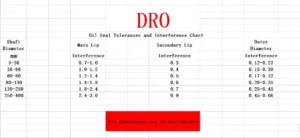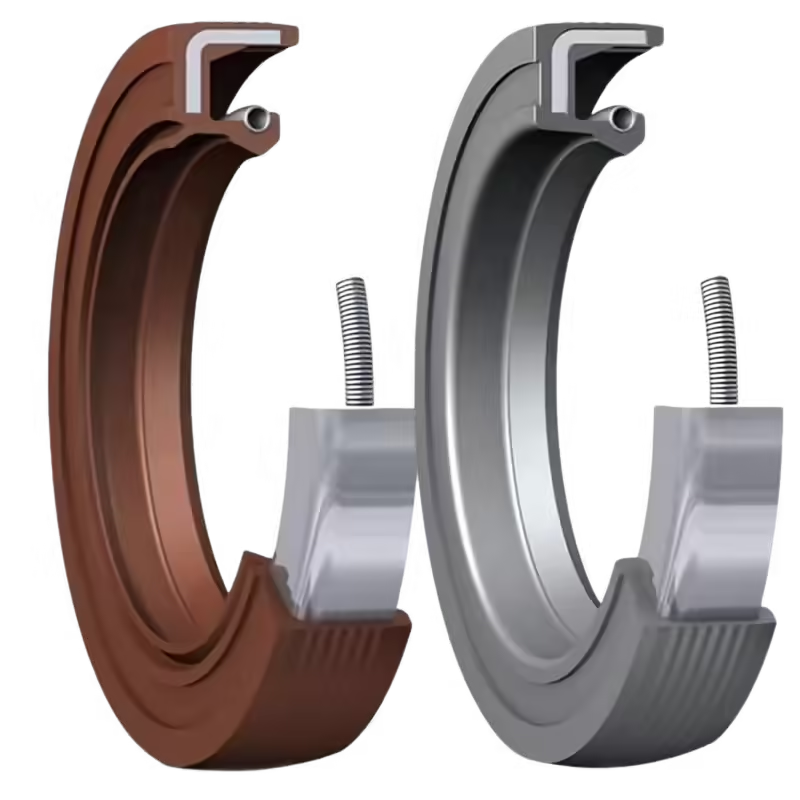Introduction
Oil seals are essential components in various machinery, designed to retain lubricants and prevent contaminants from entering mechanical systems. Accurate oil seal measurements are critical for effective replacements, manufacturing, and quality control. In this comprehensive guide, we will cover the key dimensions involved in measuring oil seals, the tools required, and the best techniques to achieve precise measurements for optimal performance in your machinery.
1. Key Dimensions to Measure for Oil Seals: Inside Diameter, Outside Diameter, and Width
When measuring an oil seal, it is essential to focus on three primary dimensions to ensure a perfect fit:
- Inside Diameter (ID): This measurement corresponds to the shaft diameter and is critical for determining the correct size of the oil seal for the shaft.
- Outside Diameter (OD): The external measurement of the oil seal, which fits into the housing or bore. Accurate OD measurements prevent leaks and ensure a secure fit.
- Width (W): The width refers to the thickness of the oil seal, including the sealing lip and casing. The correct width ensures proper sealing and durability.
In many cases, oil seals are marked with numerical labels to indicate their dimensions, making it easier to identify the correct size. For example, a label such as 507212 on a TC, TG, DC, or SC oil seal indicates the following:
- 50: The shaft diameter (Inside Diameter, ID)
- 72: The bore diameter (Outside Diameter, OD)
- 12: The thickness or width of the oil seal (W)
These key dimensions are typically expressed in millimeters (mm) or inches, depending on industry standards and regional practices.
2. Essential Tools for Accurate Oil Seal Measurements
To obtain accurate results, the correct measuring tools are necessary:
- Vernier Caliper: Ideal for measuring the Inside Diameter (ID), Outside Diameter (OD), and width (W) of oil seals. It provides precise readings for standard-sized seals.
- Micrometer: Best for measuring the oil seal’s width with high accuracy, especially for seals requiring fine tolerance.
- Measuring Tape: A less accurate tool, suitable only when a vernier caliper is unavailable, but should not be relied upon for high-precision measurements.
- Technical Catalogs and Reference Guides: These resources help cross-reference your measurements against standard seal sizes to verify compatibility.
Using these tools ensures that each oil seal measurement is accurate, leading to a proper fit and reliable performance.
3. Step-by-Step Guide to Measuring Oil Seals: Accurate Techniques for Perfect Fit
Follow these steps to measure oil seals precisely, ensuring the correct size for your application:
a. Measuring the Inside Diameter (ID)
- Place the oil seal on a flat, stable surface.
- Use the inner jaws of the vernier caliper to measure the internal opening of the oil seal.
- Ensure the caliper is perpendicular to the surface for an accurate reading.
b. Measuring the Outside Diameter (OD)
- Position the outer jaws of the vernier caliper around the seal’s outer edge.
- Rotate the seal slightly to ensure it is circular and aligned with the caliper.
- Record the largest outside diameter (OD) measurement for precision.
c. Measuring the Width (W)
- Stand the oil seal upright so that the thickness (width) is easily accessible.
- Use a vernier caliper or micrometer to measure the width.
- Apply minimal pressure to avoid deforming the seal and affecting the measurement accuracy.
d. Verifying Measurements
Once you have recorded the ID, OD, and width, compare your measurements with the manufacturer’s specifications or a standard reference chart. This ensures the oil seal will fit properly and function as intended.

4. Special Considerations When Measuring Oil Seals: Temperature, Wear, and Material Flexibility
- Worn or Damaged Seals: If measuring an older seal, the dimensions may be distorted due to wear. It is best to measure a new seal or refer to the original specifications for accuracy.
- Temperature Effects: Avoid measuring oil seals at extreme temperatures, as this can cause expansion or contraction, leading to inaccurate readings. Aim to measure seals at room temperature for optimal results.
- Material Flexibility: Rubber seals can deform under pressure. Handle the seal gently to prevent compressing it and altering the measurements.
5. Common Errors to Avoid: Ensuring Accurate Oil Seal Measurements
To avoid inaccurate measurements, be mindful of these common errors:
- Measuring While Installed: Always remove the oil seal from its housing to ensure accurate measurements. Measuring while installed can cause misalignment and lead to incorrect dimensions.
- Improper Tools: Avoid using simple rulers or non-calibrated instruments, as even small inaccuracies can result in significant measurement errors.
- Ignoring Tolerances: Every oil seal has a specified tolerance range. Consider these tolerances, especially for high-precision applications, to ensure the seal performs optimally.
6. Applications of Accurate Oil Seal Measurements: Why Precision Matters
Accurate measurements are crucial in several contexts:
- Replacement: Replacing an oil seal with one that does not match the original dimensions can result in leaks, premature wear, and mechanical failures. Ensure the new seal matches the old one precisely for optimal performance.
- Design & Manufacturing: For custom seals, precise dimensions are essential for ensuring a tight fit and preventing issues like leakage or malfunction. Accurate measurements contribute to reliable rubber seal design.
- Quality Control: Consistent measurement checks during production help maintain industry standards and ensure that every oil seal is manufactured to the required specifications.
Conclusion: Why Accurate Oil Seal Measurements Are Essential
Properly measuring oil seals is a straightforward yet vital process that significantly impacts the longevity and performance of your machinery. By using the right tools, following proper procedures, and cross-referencing your measurements with reliable data, you can ensure each oil seal is a perfect fit for your application.
For more information on oil seal measurements or to explore custom rubber sealing solutions, please contact us at:
- Website: drorubber.com
- WhatsApp: +0086 15815831911
- WeChat: +0086 13784044874





